Tourism Consumer Behaviour: Factors, Trends, and Decision Journey
VerifiedAdded on 2022/12/27
|13
|3863
|86
Report
AI Summary
This report investigates tourism consumer behavior, focusing on factors influencing consumer attitudes, the impact of digital technology on consumer trends, and the consumer decision-making journey. It examines the stages of the decision-making process, maps a purchase path for tourism services, and contrasts hospitality decision-making in B2C and B2B contexts. Additionally, the report explores different market research approaches and evaluates how marketers can influence various stages of the tourism decision-making process, emphasizing the importance of understanding consumer behavior for effective marketing strategies and customer satisfaction within the tourism industry. This assignment is available on Desklib, a platform providing study tools for students.
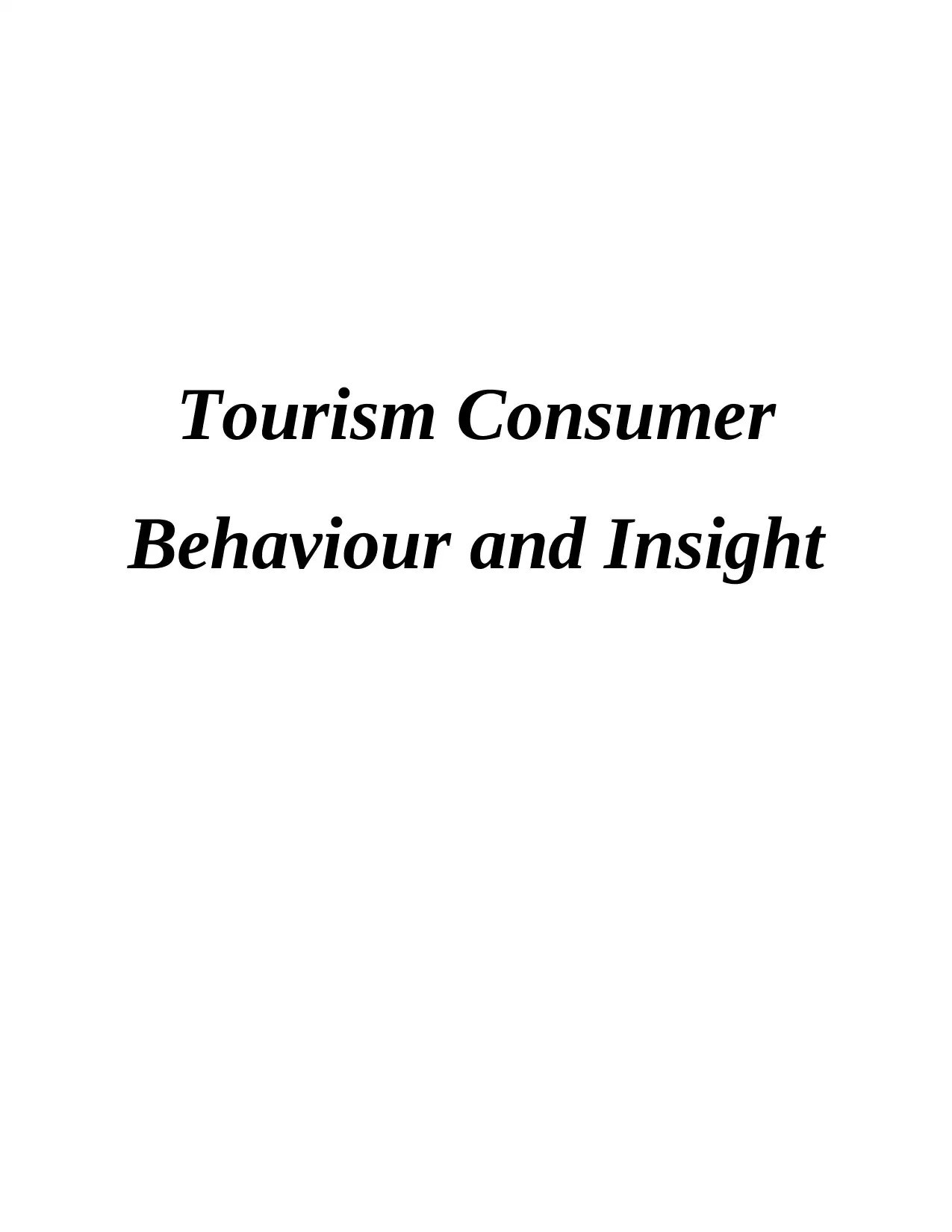
Tourism Consumer
Behaviour and Insight
Behaviour and Insight
Paraphrase This Document
Need a fresh take? Get an instant paraphrase of this document with our AI Paraphraser
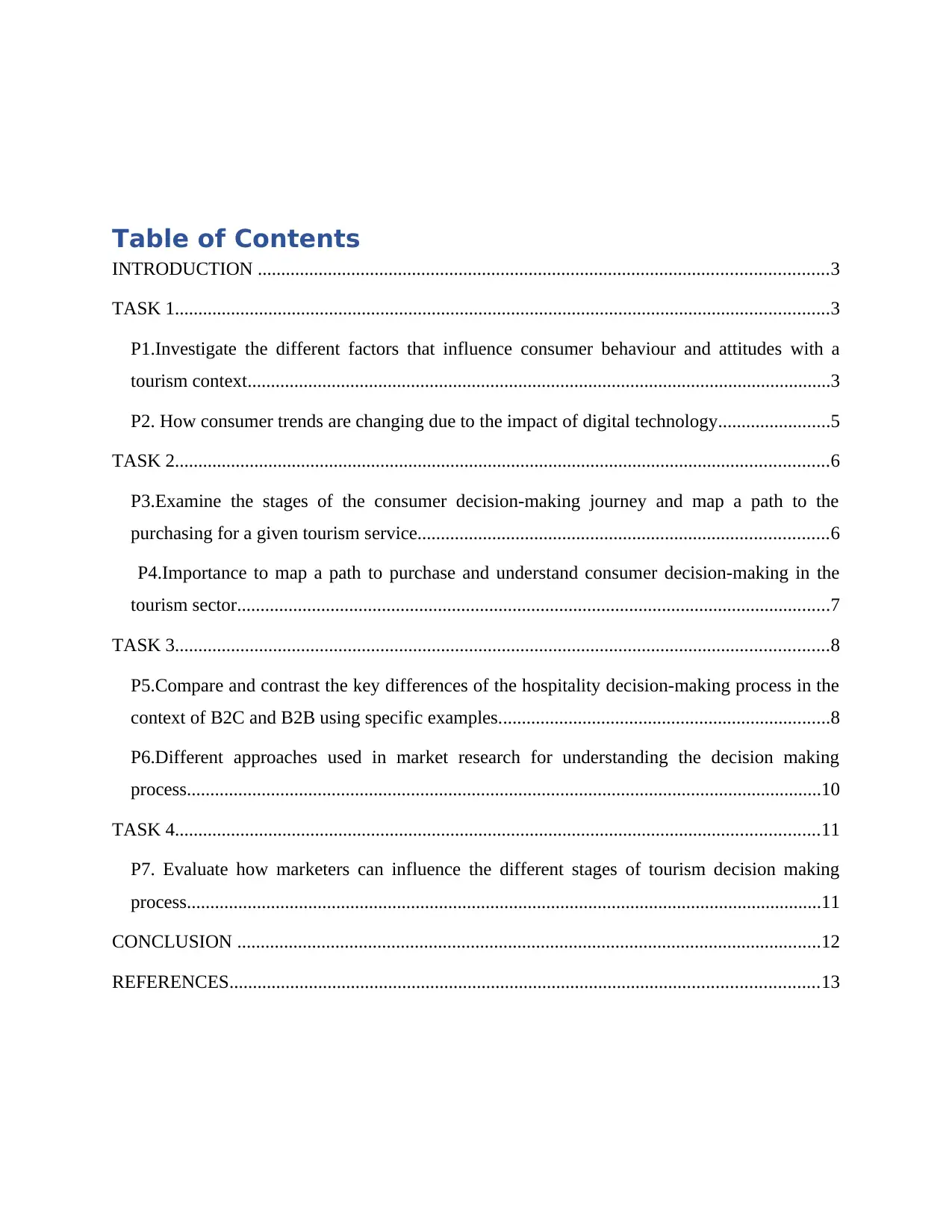
Table of Contents
INTRODUCTION ..........................................................................................................................3
TASK 1............................................................................................................................................3
P1.Investigate the different factors that influence consumer behaviour and attitudes with a
tourism context.............................................................................................................................3
P2. How consumer trends are changing due to the impact of digital technology........................5
TASK 2............................................................................................................................................6
P3.Examine the stages of the consumer decision-making journey and map a path to the
purchasing for a given tourism service........................................................................................6
P4.Importance to map a path to purchase and understand consumer decision-making in the
tourism sector...............................................................................................................................7
TASK 3............................................................................................................................................8
P5.Compare and contrast the key differences of the hospitality decision-making process in the
context of B2C and B2B using specific examples.......................................................................8
P6.Different approaches used in market research for understanding the decision making
process........................................................................................................................................10
TASK 4..........................................................................................................................................11
P7. Evaluate how marketers can influence the different stages of tourism decision making
process........................................................................................................................................11
CONCLUSION .............................................................................................................................12
REFERENCES..............................................................................................................................13
INTRODUCTION ..........................................................................................................................3
TASK 1............................................................................................................................................3
P1.Investigate the different factors that influence consumer behaviour and attitudes with a
tourism context.............................................................................................................................3
P2. How consumer trends are changing due to the impact of digital technology........................5
TASK 2............................................................................................................................................6
P3.Examine the stages of the consumer decision-making journey and map a path to the
purchasing for a given tourism service........................................................................................6
P4.Importance to map a path to purchase and understand consumer decision-making in the
tourism sector...............................................................................................................................7
TASK 3............................................................................................................................................8
P5.Compare and contrast the key differences of the hospitality decision-making process in the
context of B2C and B2B using specific examples.......................................................................8
P6.Different approaches used in market research for understanding the decision making
process........................................................................................................................................10
TASK 4..........................................................................................................................................11
P7. Evaluate how marketers can influence the different stages of tourism decision making
process........................................................................................................................................11
CONCLUSION .............................................................................................................................12
REFERENCES..............................................................................................................................13
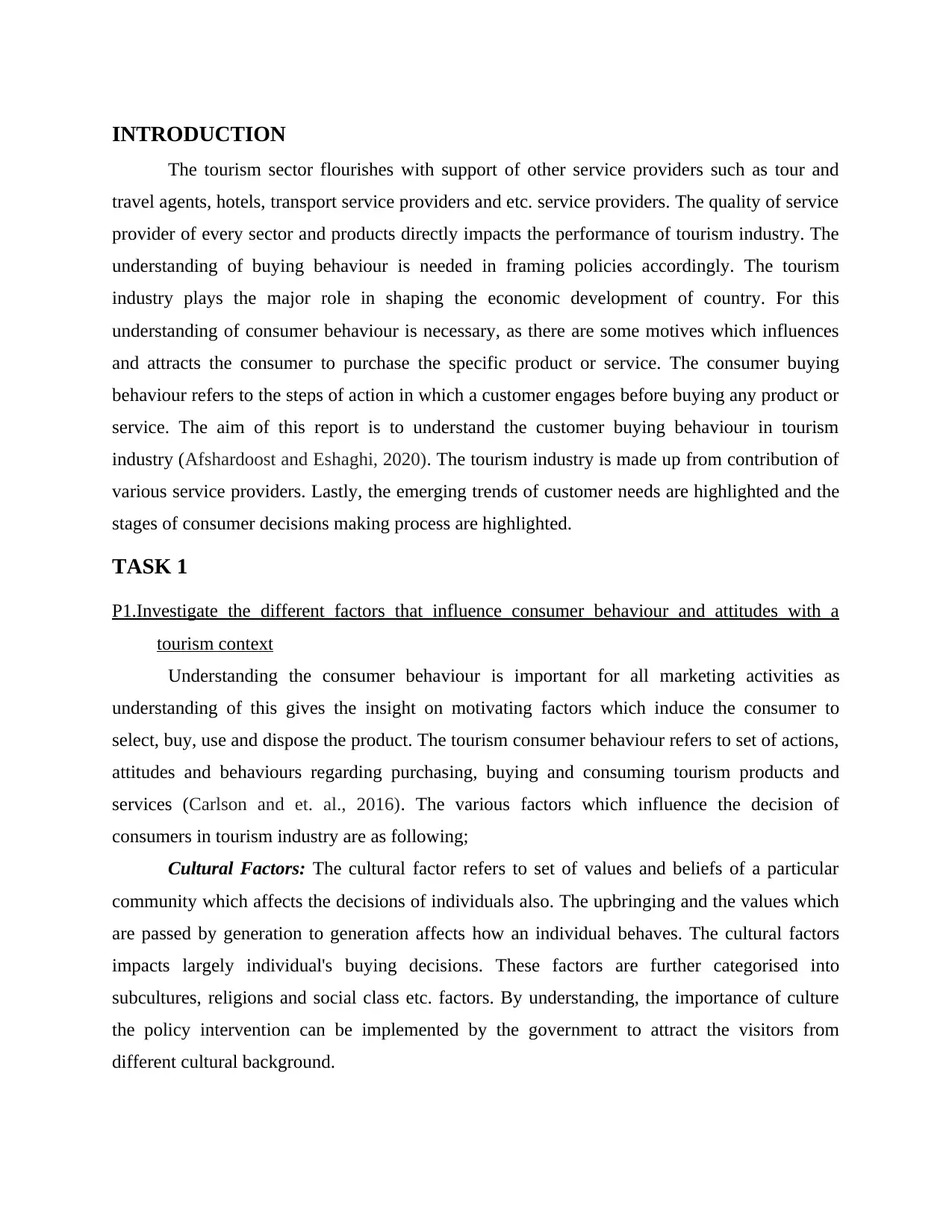
INTRODUCTION
The tourism sector flourishes with support of other service providers such as tour and
travel agents, hotels, transport service providers and etc. service providers. The quality of service
provider of every sector and products directly impacts the performance of tourism industry. The
understanding of buying behaviour is needed in framing policies accordingly. The tourism
industry plays the major role in shaping the economic development of country. For this
understanding of consumer behaviour is necessary, as there are some motives which influences
and attracts the consumer to purchase the specific product or service. The consumer buying
behaviour refers to the steps of action in which a customer engages before buying any product or
service. The aim of this report is to understand the customer buying behaviour in tourism
industry (Afshardoost and Eshaghi, 2020). The tourism industry is made up from contribution of
various service providers. Lastly, the emerging trends of customer needs are highlighted and the
stages of consumer decisions making process are highlighted.
TASK 1
P1.Investigate the different factors that influence consumer behaviour and attitudes with a
tourism context
Understanding the consumer behaviour is important for all marketing activities as
understanding of this gives the insight on motivating factors which induce the consumer to
select, buy, use and dispose the product. The tourism consumer behaviour refers to set of actions,
attitudes and behaviours regarding purchasing, buying and consuming tourism products and
services (Carlson and et. al., 2016). The various factors which influence the decision of
consumers in tourism industry are as following;
Cultural Factors: The cultural factor refers to set of values and beliefs of a particular
community which affects the decisions of individuals also. The upbringing and the values which
are passed by generation to generation affects how an individual behaves. The cultural factors
impacts largely individual's buying decisions. These factors are further categorised into
subcultures, religions and social class etc. factors. By understanding, the importance of culture
the policy intervention can be implemented by the government to attract the visitors from
different cultural background.
The tourism sector flourishes with support of other service providers such as tour and
travel agents, hotels, transport service providers and etc. service providers. The quality of service
provider of every sector and products directly impacts the performance of tourism industry. The
understanding of buying behaviour is needed in framing policies accordingly. The tourism
industry plays the major role in shaping the economic development of country. For this
understanding of consumer behaviour is necessary, as there are some motives which influences
and attracts the consumer to purchase the specific product or service. The consumer buying
behaviour refers to the steps of action in which a customer engages before buying any product or
service. The aim of this report is to understand the customer buying behaviour in tourism
industry (Afshardoost and Eshaghi, 2020). The tourism industry is made up from contribution of
various service providers. Lastly, the emerging trends of customer needs are highlighted and the
stages of consumer decisions making process are highlighted.
TASK 1
P1.Investigate the different factors that influence consumer behaviour and attitudes with a
tourism context
Understanding the consumer behaviour is important for all marketing activities as
understanding of this gives the insight on motivating factors which induce the consumer to
select, buy, use and dispose the product. The tourism consumer behaviour refers to set of actions,
attitudes and behaviours regarding purchasing, buying and consuming tourism products and
services (Carlson and et. al., 2016). The various factors which influence the decision of
consumers in tourism industry are as following;
Cultural Factors: The cultural factor refers to set of values and beliefs of a particular
community which affects the decisions of individuals also. The upbringing and the values which
are passed by generation to generation affects how an individual behaves. The cultural factors
impacts largely individual's buying decisions. These factors are further categorised into
subcultures, religions and social class etc. factors. By understanding, the importance of culture
the policy intervention can be implemented by the government to attract the visitors from
different cultural background.
⊘ This is a preview!⊘
Do you want full access?
Subscribe today to unlock all pages.

Trusted by 1+ million students worldwide
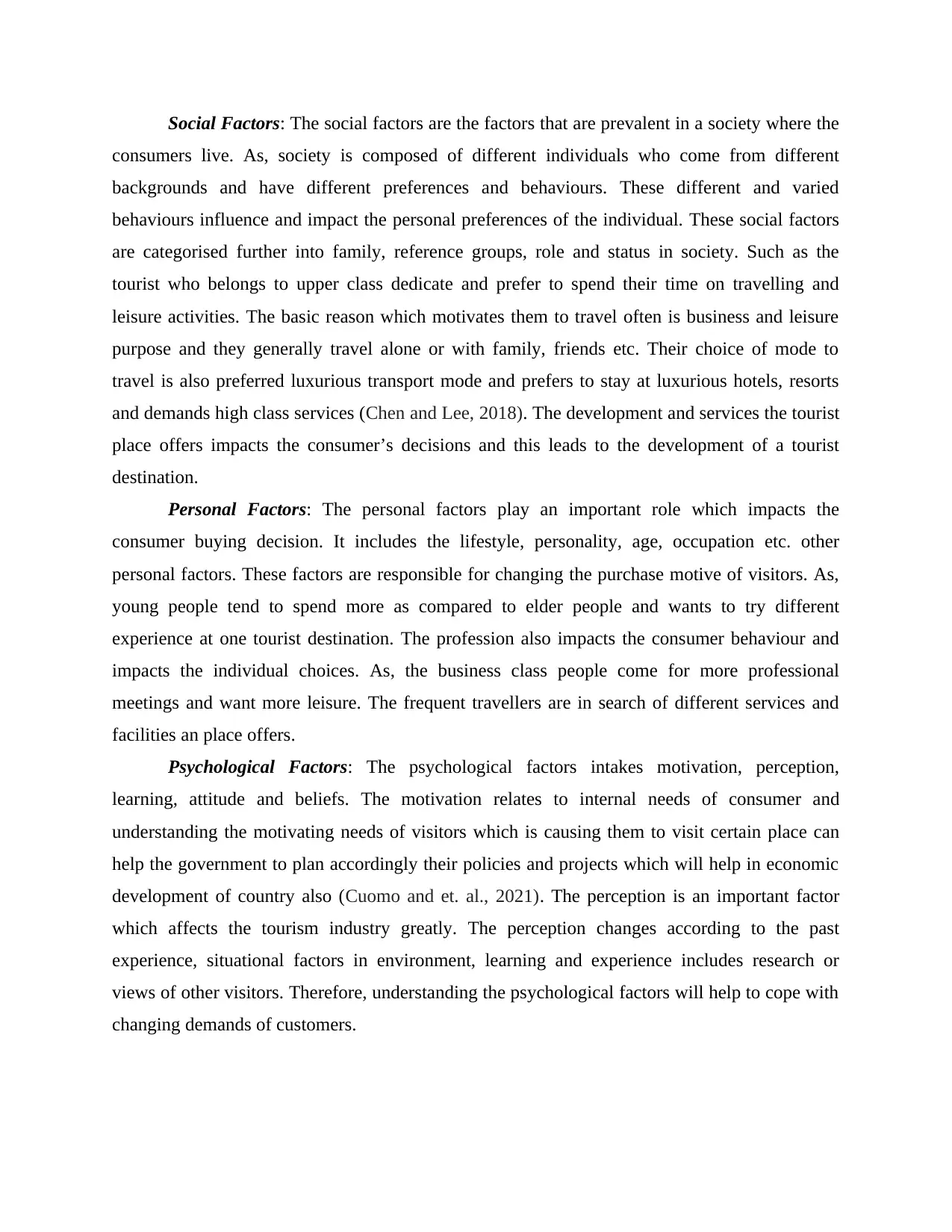
Social Factors: The social factors are the factors that are prevalent in a society where the
consumers live. As, society is composed of different individuals who come from different
backgrounds and have different preferences and behaviours. These different and varied
behaviours influence and impact the personal preferences of the individual. These social factors
are categorised further into family, reference groups, role and status in society. Such as the
tourist who belongs to upper class dedicate and prefer to spend their time on travelling and
leisure activities. The basic reason which motivates them to travel often is business and leisure
purpose and they generally travel alone or with family, friends etc. Their choice of mode to
travel is also preferred luxurious transport mode and prefers to stay at luxurious hotels, resorts
and demands high class services (Chen and Lee, 2018). The development and services the tourist
place offers impacts the consumer’s decisions and this leads to the development of a tourist
destination.
Personal Factors: The personal factors play an important role which impacts the
consumer buying decision. It includes the lifestyle, personality, age, occupation etc. other
personal factors. These factors are responsible for changing the purchase motive of visitors. As,
young people tend to spend more as compared to elder people and wants to try different
experience at one tourist destination. The profession also impacts the consumer behaviour and
impacts the individual choices. As, the business class people come for more professional
meetings and want more leisure. The frequent travellers are in search of different services and
facilities an place offers.
Psychological Factors: The psychological factors intakes motivation, perception,
learning, attitude and beliefs. The motivation relates to internal needs of consumer and
understanding the motivating needs of visitors which is causing them to visit certain place can
help the government to plan accordingly their policies and projects which will help in economic
development of country also (Cuomo and et. al., 2021). The perception is an important factor
which affects the tourism industry greatly. The perception changes according to the past
experience, situational factors in environment, learning and experience includes research or
views of other visitors. Therefore, understanding the psychological factors will help to cope with
changing demands of customers.
consumers live. As, society is composed of different individuals who come from different
backgrounds and have different preferences and behaviours. These different and varied
behaviours influence and impact the personal preferences of the individual. These social factors
are categorised further into family, reference groups, role and status in society. Such as the
tourist who belongs to upper class dedicate and prefer to spend their time on travelling and
leisure activities. The basic reason which motivates them to travel often is business and leisure
purpose and they generally travel alone or with family, friends etc. Their choice of mode to
travel is also preferred luxurious transport mode and prefers to stay at luxurious hotels, resorts
and demands high class services (Chen and Lee, 2018). The development and services the tourist
place offers impacts the consumer’s decisions and this leads to the development of a tourist
destination.
Personal Factors: The personal factors play an important role which impacts the
consumer buying decision. It includes the lifestyle, personality, age, occupation etc. other
personal factors. These factors are responsible for changing the purchase motive of visitors. As,
young people tend to spend more as compared to elder people and wants to try different
experience at one tourist destination. The profession also impacts the consumer behaviour and
impacts the individual choices. As, the business class people come for more professional
meetings and want more leisure. The frequent travellers are in search of different services and
facilities an place offers.
Psychological Factors: The psychological factors intakes motivation, perception,
learning, attitude and beliefs. The motivation relates to internal needs of consumer and
understanding the motivating needs of visitors which is causing them to visit certain place can
help the government to plan accordingly their policies and projects which will help in economic
development of country also (Cuomo and et. al., 2021). The perception is an important factor
which affects the tourism industry greatly. The perception changes according to the past
experience, situational factors in environment, learning and experience includes research or
views of other visitors. Therefore, understanding the psychological factors will help to cope with
changing demands of customers.
Paraphrase This Document
Need a fresh take? Get an instant paraphrase of this document with our AI Paraphraser
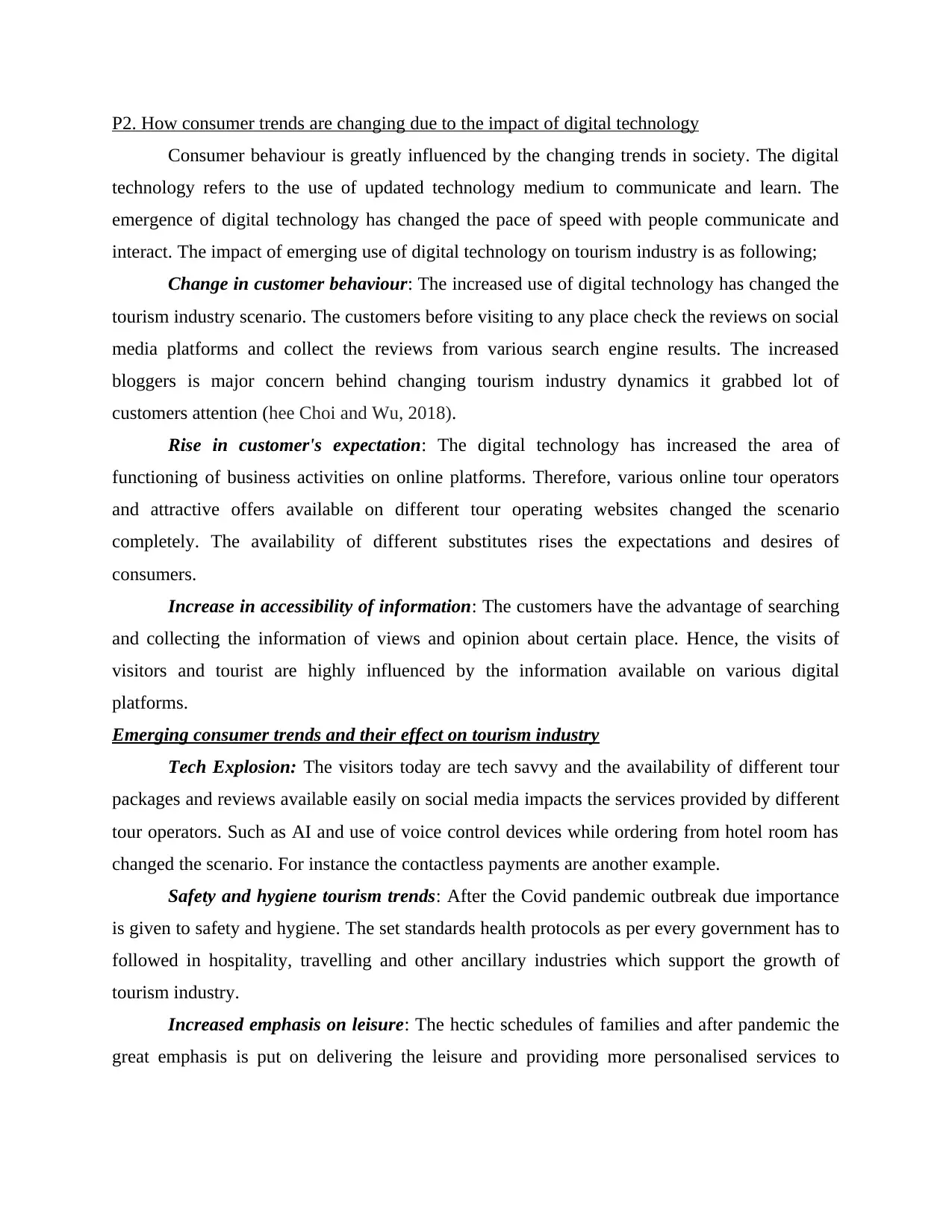
P2. How consumer trends are changing due to the impact of digital technology
Consumer behaviour is greatly influenced by the changing trends in society. The digital
technology refers to the use of updated technology medium to communicate and learn. The
emergence of digital technology has changed the pace of speed with people communicate and
interact. The impact of emerging use of digital technology on tourism industry is as following;
Change in customer behaviour: The increased use of digital technology has changed the
tourism industry scenario. The customers before visiting to any place check the reviews on social
media platforms and collect the reviews from various search engine results. The increased
bloggers is major concern behind changing tourism industry dynamics it grabbed lot of
customers attention (hee Choi and Wu, 2018).
Rise in customer's expectation: The digital technology has increased the area of
functioning of business activities on online platforms. Therefore, various online tour operators
and attractive offers available on different tour operating websites changed the scenario
completely. The availability of different substitutes rises the expectations and desires of
consumers.
Increase in accessibility of information: The customers have the advantage of searching
and collecting the information of views and opinion about certain place. Hence, the visits of
visitors and tourist are highly influenced by the information available on various digital
platforms.
Emerging consumer trends and their effect on tourism industry
Tech Explosion: The visitors today are tech savvy and the availability of different tour
packages and reviews available easily on social media impacts the services provided by different
tour operators. Such as AI and use of voice control devices while ordering from hotel room has
changed the scenario. For instance the contactless payments are another example.
Safety and hygiene tourism trends: After the Covid pandemic outbreak due importance
is given to safety and hygiene. The set standards health protocols as per every government has to
followed in hospitality, travelling and other ancillary industries which support the growth of
tourism industry.
Increased emphasis on leisure: The hectic schedules of families and after pandemic the
great emphasis is put on delivering the leisure and providing more personalised services to
Consumer behaviour is greatly influenced by the changing trends in society. The digital
technology refers to the use of updated technology medium to communicate and learn. The
emergence of digital technology has changed the pace of speed with people communicate and
interact. The impact of emerging use of digital technology on tourism industry is as following;
Change in customer behaviour: The increased use of digital technology has changed the
tourism industry scenario. The customers before visiting to any place check the reviews on social
media platforms and collect the reviews from various search engine results. The increased
bloggers is major concern behind changing tourism industry dynamics it grabbed lot of
customers attention (hee Choi and Wu, 2018).
Rise in customer's expectation: The digital technology has increased the area of
functioning of business activities on online platforms. Therefore, various online tour operators
and attractive offers available on different tour operating websites changed the scenario
completely. The availability of different substitutes rises the expectations and desires of
consumers.
Increase in accessibility of information: The customers have the advantage of searching
and collecting the information of views and opinion about certain place. Hence, the visits of
visitors and tourist are highly influenced by the information available on various digital
platforms.
Emerging consumer trends and their effect on tourism industry
Tech Explosion: The visitors today are tech savvy and the availability of different tour
packages and reviews available easily on social media impacts the services provided by different
tour operators. Such as AI and use of voice control devices while ordering from hotel room has
changed the scenario. For instance the contactless payments are another example.
Safety and hygiene tourism trends: After the Covid pandemic outbreak due importance
is given to safety and hygiene. The set standards health protocols as per every government has to
followed in hospitality, travelling and other ancillary industries which support the growth of
tourism industry.
Increased emphasis on leisure: The hectic schedules of families and after pandemic the
great emphasis is put on delivering the leisure and providing more personalised services to
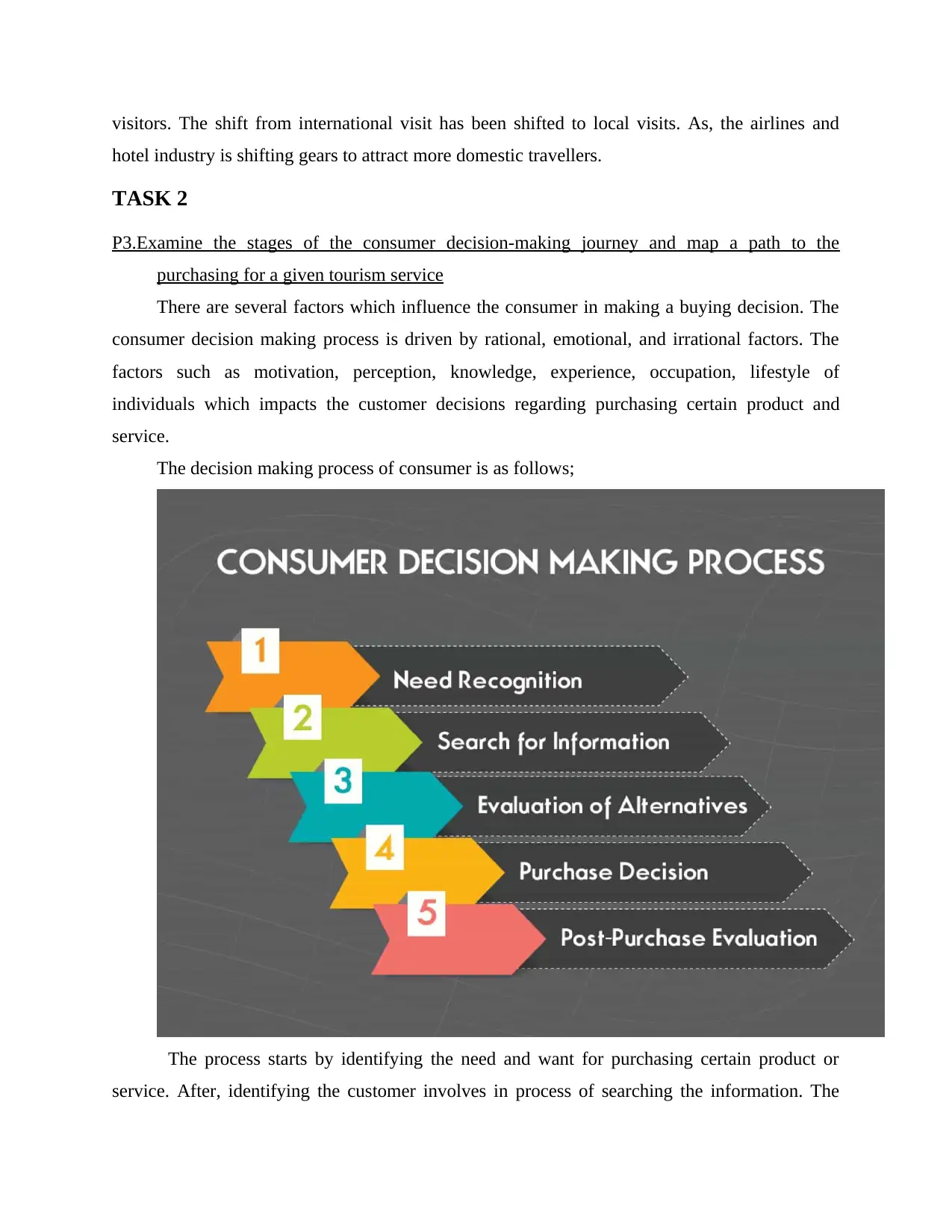
visitors. The shift from international visit has been shifted to local visits. As, the airlines and
hotel industry is shifting gears to attract more domestic travellers.
TASK 2
P3.Examine the stages of the consumer decision-making journey and map a path to the
purchasing for a given tourism service
There are several factors which influence the consumer in making a buying decision. The
consumer decision making process is driven by rational, emotional, and irrational factors. The
factors such as motivation, perception, knowledge, experience, occupation, lifestyle of
individuals which impacts the customer decisions regarding purchasing certain product and
service.
The decision making process of consumer is as follows;
The process starts by identifying the need and want for purchasing certain product or
service. After, identifying the customer involves in process of searching the information. The
hotel industry is shifting gears to attract more domestic travellers.
TASK 2
P3.Examine the stages of the consumer decision-making journey and map a path to the
purchasing for a given tourism service
There are several factors which influence the consumer in making a buying decision. The
consumer decision making process is driven by rational, emotional, and irrational factors. The
factors such as motivation, perception, knowledge, experience, occupation, lifestyle of
individuals which impacts the customer decisions regarding purchasing certain product and
service.
The decision making process of consumer is as follows;
The process starts by identifying the need and want for purchasing certain product or
service. After, identifying the customer involves in process of searching the information. The
⊘ This is a preview!⊘
Do you want full access?
Subscribe today to unlock all pages.

Trusted by 1+ million students worldwide
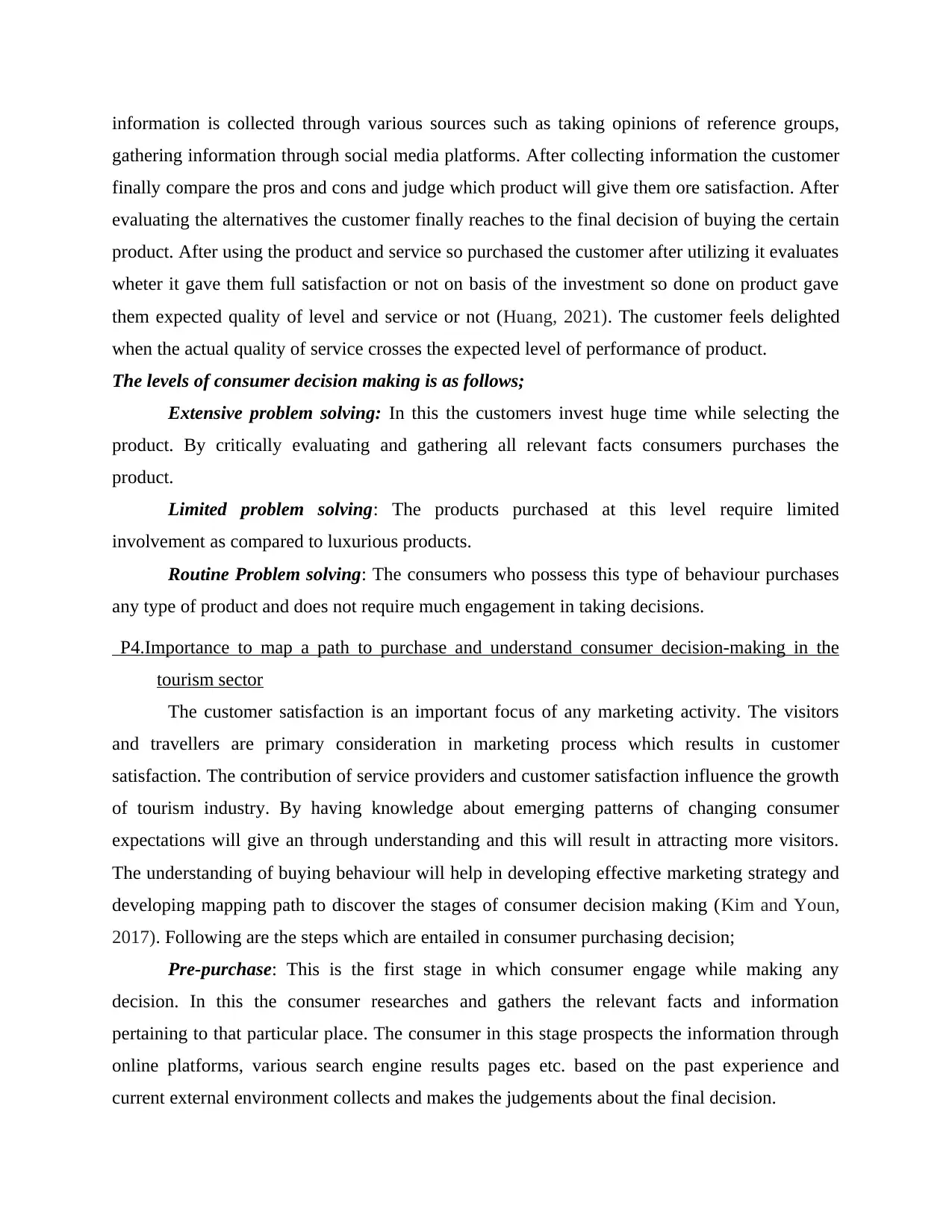
information is collected through various sources such as taking opinions of reference groups,
gathering information through social media platforms. After collecting information the customer
finally compare the pros and cons and judge which product will give them ore satisfaction. After
evaluating the alternatives the customer finally reaches to the final decision of buying the certain
product. After using the product and service so purchased the customer after utilizing it evaluates
wheter it gave them full satisfaction or not on basis of the investment so done on product gave
them expected quality of level and service or not (Huang, 2021). The customer feels delighted
when the actual quality of service crosses the expected level of performance of product.
The levels of consumer decision making is as follows;
Extensive problem solving: In this the customers invest huge time while selecting the
product. By critically evaluating and gathering all relevant facts consumers purchases the
product.
Limited problem solving: The products purchased at this level require limited
involvement as compared to luxurious products.
Routine Problem solving: The consumers who possess this type of behaviour purchases
any type of product and does not require much engagement in taking decisions.
P4.Importance to map a path to purchase and understand consumer decision-making in the
tourism sector
The customer satisfaction is an important focus of any marketing activity. The visitors
and travellers are primary consideration in marketing process which results in customer
satisfaction. The contribution of service providers and customer satisfaction influence the growth
of tourism industry. By having knowledge about emerging patterns of changing consumer
expectations will give an through understanding and this will result in attracting more visitors.
The understanding of buying behaviour will help in developing effective marketing strategy and
developing mapping path to discover the stages of consumer decision making (Kim and Youn,
2017). Following are the steps which are entailed in consumer purchasing decision;
Pre-purchase: This is the first stage in which consumer engage while making any
decision. In this the consumer researches and gathers the relevant facts and information
pertaining to that particular place. The consumer in this stage prospects the information through
online platforms, various search engine results pages etc. based on the past experience and
current external environment collects and makes the judgements about the final decision.
gathering information through social media platforms. After collecting information the customer
finally compare the pros and cons and judge which product will give them ore satisfaction. After
evaluating the alternatives the customer finally reaches to the final decision of buying the certain
product. After using the product and service so purchased the customer after utilizing it evaluates
wheter it gave them full satisfaction or not on basis of the investment so done on product gave
them expected quality of level and service or not (Huang, 2021). The customer feels delighted
when the actual quality of service crosses the expected level of performance of product.
The levels of consumer decision making is as follows;
Extensive problem solving: In this the customers invest huge time while selecting the
product. By critically evaluating and gathering all relevant facts consumers purchases the
product.
Limited problem solving: The products purchased at this level require limited
involvement as compared to luxurious products.
Routine Problem solving: The consumers who possess this type of behaviour purchases
any type of product and does not require much engagement in taking decisions.
P4.Importance to map a path to purchase and understand consumer decision-making in the
tourism sector
The customer satisfaction is an important focus of any marketing activity. The visitors
and travellers are primary consideration in marketing process which results in customer
satisfaction. The contribution of service providers and customer satisfaction influence the growth
of tourism industry. By having knowledge about emerging patterns of changing consumer
expectations will give an through understanding and this will result in attracting more visitors.
The understanding of buying behaviour will help in developing effective marketing strategy and
developing mapping path to discover the stages of consumer decision making (Kim and Youn,
2017). Following are the steps which are entailed in consumer purchasing decision;
Pre-purchase: This is the first stage in which consumer engage while making any
decision. In this the consumer researches and gathers the relevant facts and information
pertaining to that particular place. The consumer in this stage prospects the information through
online platforms, various search engine results pages etc. based on the past experience and
current external environment collects and makes the judgements about the final decision.
Paraphrase This Document
Need a fresh take? Get an instant paraphrase of this document with our AI Paraphraser
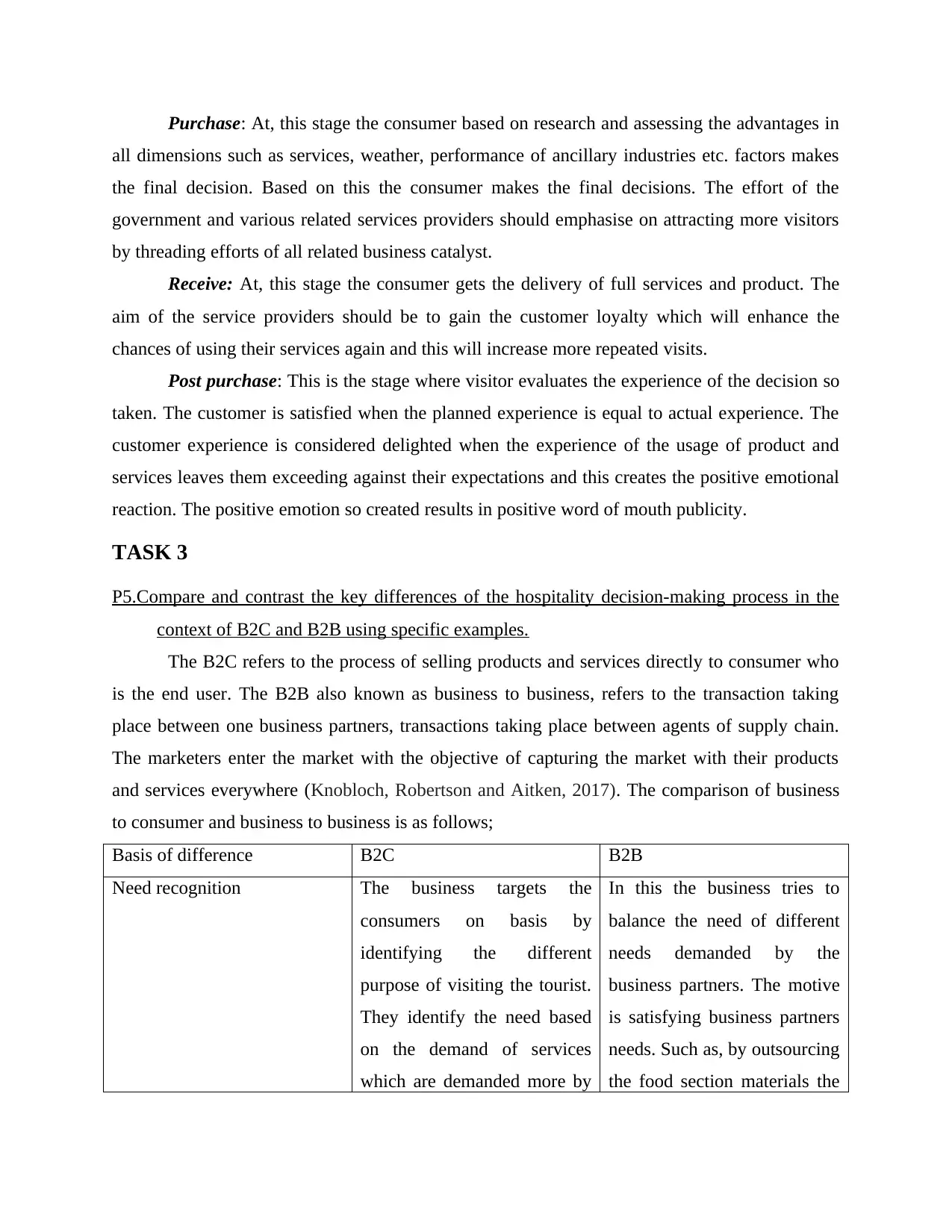
Purchase: At, this stage the consumer based on research and assessing the advantages in
all dimensions such as services, weather, performance of ancillary industries etc. factors makes
the final decision. Based on this the consumer makes the final decisions. The effort of the
government and various related services providers should emphasise on attracting more visitors
by threading efforts of all related business catalyst.
Receive: At, this stage the consumer gets the delivery of full services and product. The
aim of the service providers should be to gain the customer loyalty which will enhance the
chances of using their services again and this will increase more repeated visits.
Post purchase: This is the stage where visitor evaluates the experience of the decision so
taken. The customer is satisfied when the planned experience is equal to actual experience. The
customer experience is considered delighted when the experience of the usage of product and
services leaves them exceeding against their expectations and this creates the positive emotional
reaction. The positive emotion so created results in positive word of mouth publicity.
TASK 3
P5.Compare and contrast the key differences of the hospitality decision-making process in the
context of B2C and B2B using specific examples.
The B2C refers to the process of selling products and services directly to consumer who
is the end user. The B2B also known as business to business, refers to the transaction taking
place between one business partners, transactions taking place between agents of supply chain.
The marketers enter the market with the objective of capturing the market with their products
and services everywhere (Knobloch, Robertson and Aitken, 2017). The comparison of business
to consumer and business to business is as follows;
Basis of difference B2C B2B
Need recognition The business targets the
consumers on basis by
identifying the different
purpose of visiting the tourist.
They identify the need based
on the demand of services
which are demanded more by
In this the business tries to
balance the need of different
needs demanded by the
business partners. The motive
is satisfying business partners
needs. Such as, by outsourcing
the food section materials the
all dimensions such as services, weather, performance of ancillary industries etc. factors makes
the final decision. Based on this the consumer makes the final decisions. The effort of the
government and various related services providers should emphasise on attracting more visitors
by threading efforts of all related business catalyst.
Receive: At, this stage the consumer gets the delivery of full services and product. The
aim of the service providers should be to gain the customer loyalty which will enhance the
chances of using their services again and this will increase more repeated visits.
Post purchase: This is the stage where visitor evaluates the experience of the decision so
taken. The customer is satisfied when the planned experience is equal to actual experience. The
customer experience is considered delighted when the experience of the usage of product and
services leaves them exceeding against their expectations and this creates the positive emotional
reaction. The positive emotion so created results in positive word of mouth publicity.
TASK 3
P5.Compare and contrast the key differences of the hospitality decision-making process in the
context of B2C and B2B using specific examples.
The B2C refers to the process of selling products and services directly to consumer who
is the end user. The B2B also known as business to business, refers to the transaction taking
place between one business partners, transactions taking place between agents of supply chain.
The marketers enter the market with the objective of capturing the market with their products
and services everywhere (Knobloch, Robertson and Aitken, 2017). The comparison of business
to consumer and business to business is as follows;
Basis of difference B2C B2B
Need recognition The business targets the
consumers on basis by
identifying the different
purpose of visiting the tourist.
They identify the need based
on the demand of services
which are demanded more by
In this the business tries to
balance the need of different
needs demanded by the
business partners. The motive
is satisfying business partners
needs. Such as, by outsourcing
the food section materials the
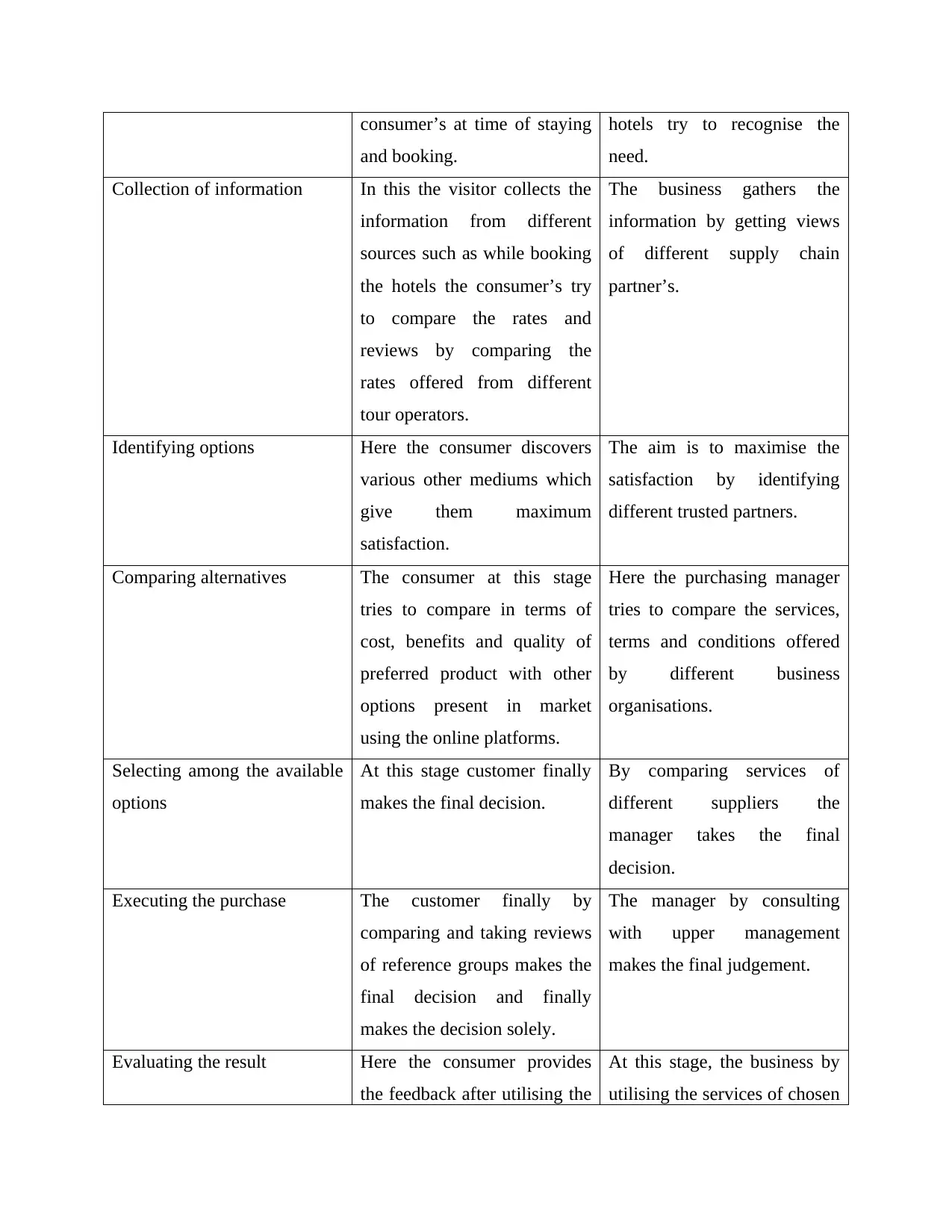
consumer’s at time of staying
and booking.
hotels try to recognise the
need.
Collection of information In this the visitor collects the
information from different
sources such as while booking
the hotels the consumer’s try
to compare the rates and
reviews by comparing the
rates offered from different
tour operators.
The business gathers the
information by getting views
of different supply chain
partner’s.
Identifying options Here the consumer discovers
various other mediums which
give them maximum
satisfaction.
The aim is to maximise the
satisfaction by identifying
different trusted partners.
Comparing alternatives The consumer at this stage
tries to compare in terms of
cost, benefits and quality of
preferred product with other
options present in market
using the online platforms.
Here the purchasing manager
tries to compare the services,
terms and conditions offered
by different business
organisations.
Selecting among the available
options
At this stage customer finally
makes the final decision.
By comparing services of
different suppliers the
manager takes the final
decision.
Executing the purchase The customer finally by
comparing and taking reviews
of reference groups makes the
final decision and finally
makes the decision solely.
The manager by consulting
with upper management
makes the final judgement.
Evaluating the result Here the consumer provides
the feedback after utilising the
At this stage, the business by
utilising the services of chosen
and booking.
hotels try to recognise the
need.
Collection of information In this the visitor collects the
information from different
sources such as while booking
the hotels the consumer’s try
to compare the rates and
reviews by comparing the
rates offered from different
tour operators.
The business gathers the
information by getting views
of different supply chain
partner’s.
Identifying options Here the consumer discovers
various other mediums which
give them maximum
satisfaction.
The aim is to maximise the
satisfaction by identifying
different trusted partners.
Comparing alternatives The consumer at this stage
tries to compare in terms of
cost, benefits and quality of
preferred product with other
options present in market
using the online platforms.
Here the purchasing manager
tries to compare the services,
terms and conditions offered
by different business
organisations.
Selecting among the available
options
At this stage customer finally
makes the final decision.
By comparing services of
different suppliers the
manager takes the final
decision.
Executing the purchase The customer finally by
comparing and taking reviews
of reference groups makes the
final decision and finally
makes the decision solely.
The manager by consulting
with upper management
makes the final judgement.
Evaluating the result Here the consumer provides
the feedback after utilising the
At this stage, the business by
utilising the services of chosen
⊘ This is a preview!⊘
Do you want full access?
Subscribe today to unlock all pages.

Trusted by 1+ million students worldwide
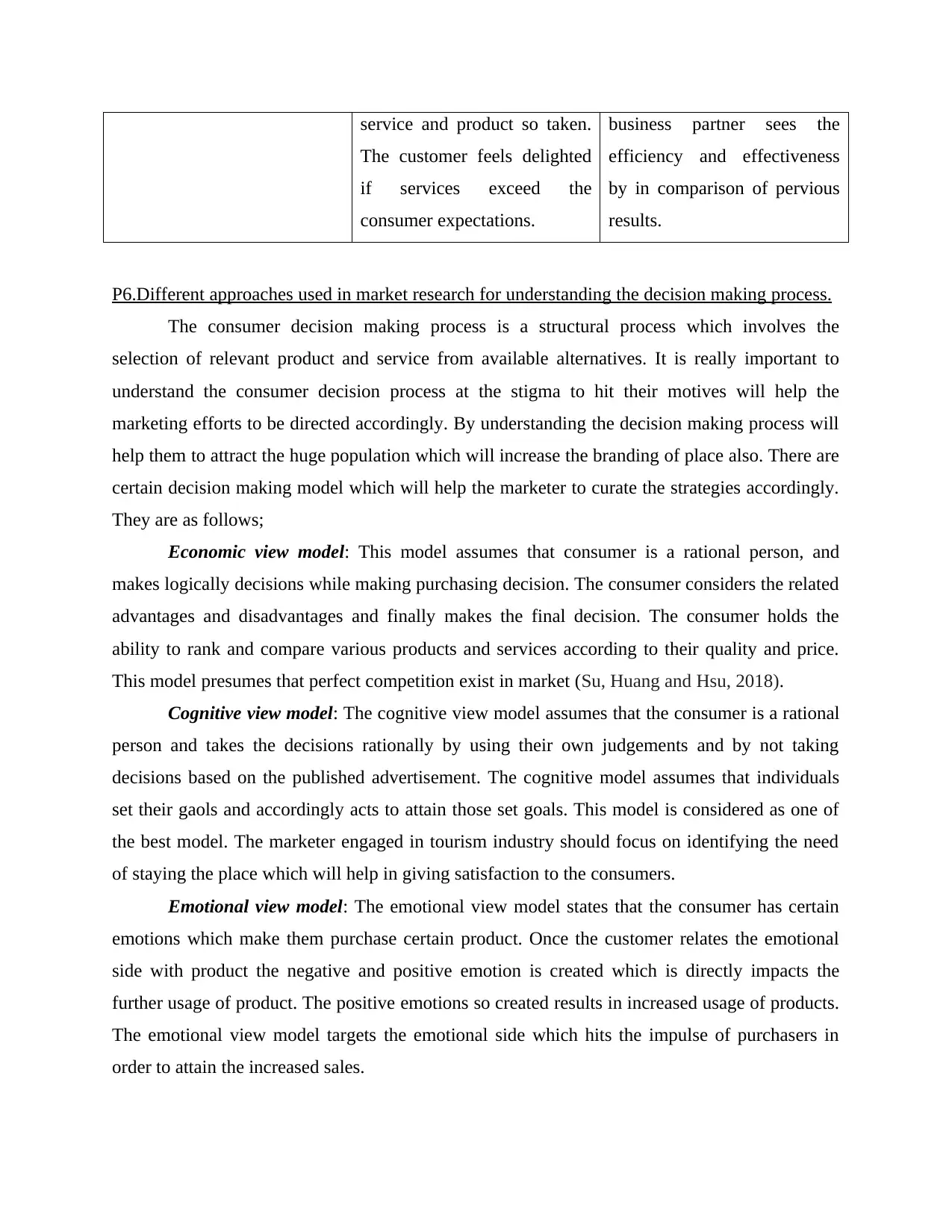
service and product so taken.
The customer feels delighted
if services exceed the
consumer expectations.
business partner sees the
efficiency and effectiveness
by in comparison of pervious
results.
P6.Different approaches used in market research for understanding the decision making process.
The consumer decision making process is a structural process which involves the
selection of relevant product and service from available alternatives. It is really important to
understand the consumer decision process at the stigma to hit their motives will help the
marketing efforts to be directed accordingly. By understanding the decision making process will
help them to attract the huge population which will increase the branding of place also. There are
certain decision making model which will help the marketer to curate the strategies accordingly.
They are as follows;
Economic view model: This model assumes that consumer is a rational person, and
makes logically decisions while making purchasing decision. The consumer considers the related
advantages and disadvantages and finally makes the final decision. The consumer holds the
ability to rank and compare various products and services according to their quality and price.
This model presumes that perfect competition exist in market (Su, Huang and Hsu, 2018).
Cognitive view model: The cognitive view model assumes that the consumer is a rational
person and takes the decisions rationally by using their own judgements and by not taking
decisions based on the published advertisement. The cognitive model assumes that individuals
set their gaols and accordingly acts to attain those set goals. This model is considered as one of
the best model. The marketer engaged in tourism industry should focus on identifying the need
of staying the place which will help in giving satisfaction to the consumers.
Emotional view model: The emotional view model states that the consumer has certain
emotions which make them purchase certain product. Once the customer relates the emotional
side with product the negative and positive emotion is created which is directly impacts the
further usage of product. The positive emotions so created results in increased usage of products.
The emotional view model targets the emotional side which hits the impulse of purchasers in
order to attain the increased sales.
The customer feels delighted
if services exceed the
consumer expectations.
business partner sees the
efficiency and effectiveness
by in comparison of pervious
results.
P6.Different approaches used in market research for understanding the decision making process.
The consumer decision making process is a structural process which involves the
selection of relevant product and service from available alternatives. It is really important to
understand the consumer decision process at the stigma to hit their motives will help the
marketing efforts to be directed accordingly. By understanding the decision making process will
help them to attract the huge population which will increase the branding of place also. There are
certain decision making model which will help the marketer to curate the strategies accordingly.
They are as follows;
Economic view model: This model assumes that consumer is a rational person, and
makes logically decisions while making purchasing decision. The consumer considers the related
advantages and disadvantages and finally makes the final decision. The consumer holds the
ability to rank and compare various products and services according to their quality and price.
This model presumes that perfect competition exist in market (Su, Huang and Hsu, 2018).
Cognitive view model: The cognitive view model assumes that the consumer is a rational
person and takes the decisions rationally by using their own judgements and by not taking
decisions based on the published advertisement. The cognitive model assumes that individuals
set their gaols and accordingly acts to attain those set goals. This model is considered as one of
the best model. The marketer engaged in tourism industry should focus on identifying the need
of staying the place which will help in giving satisfaction to the consumers.
Emotional view model: The emotional view model states that the consumer has certain
emotions which make them purchase certain product. Once the customer relates the emotional
side with product the negative and positive emotion is created which is directly impacts the
further usage of product. The positive emotions so created results in increased usage of products.
The emotional view model targets the emotional side which hits the impulse of purchasers in
order to attain the increased sales.
Paraphrase This Document
Need a fresh take? Get an instant paraphrase of this document with our AI Paraphraser
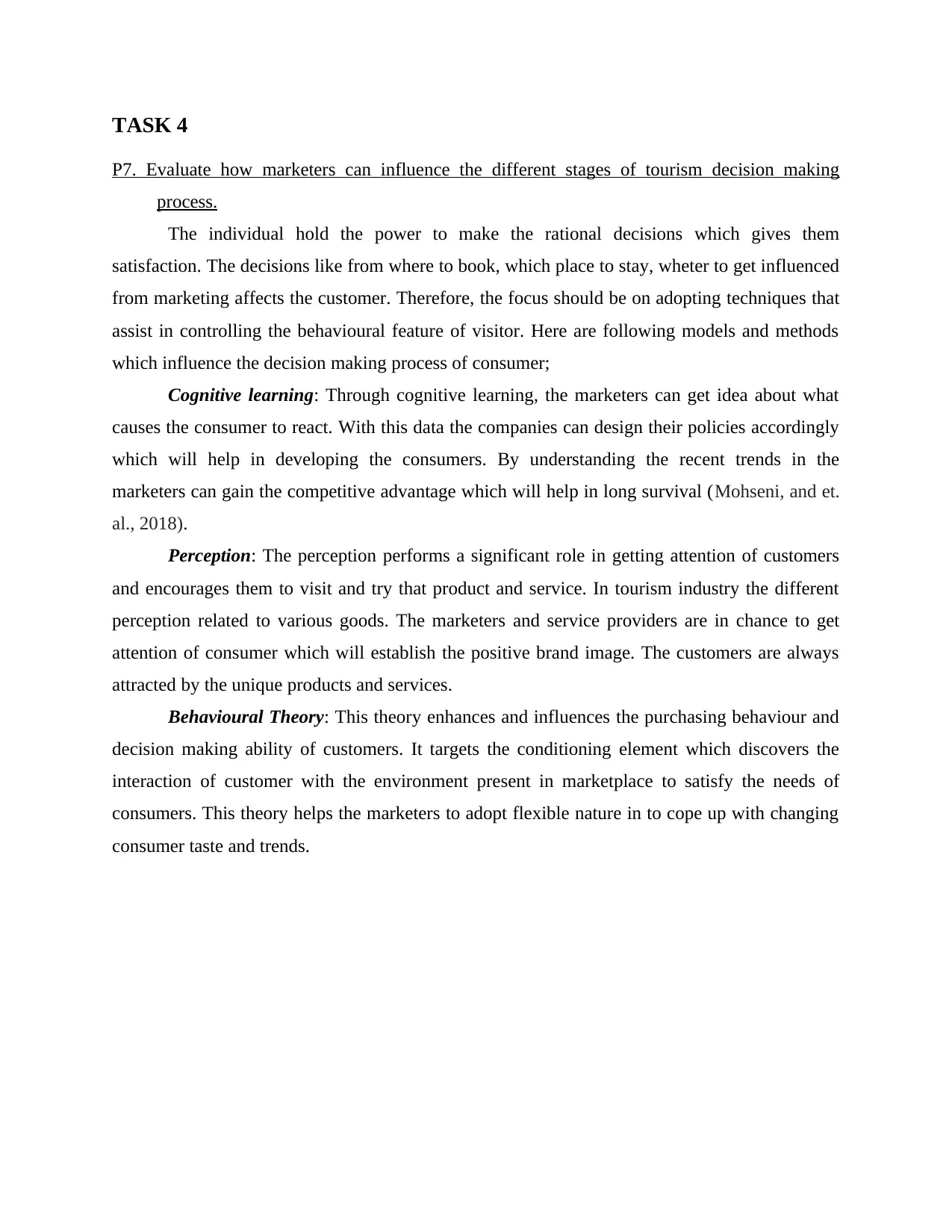
TASK 4
P7. Evaluate how marketers can influence the different stages of tourism decision making
process.
The individual hold the power to make the rational decisions which gives them
satisfaction. The decisions like from where to book, which place to stay, wheter to get influenced
from marketing affects the customer. Therefore, the focus should be on adopting techniques that
assist in controlling the behavioural feature of visitor. Here are following models and methods
which influence the decision making process of consumer;
Cognitive learning: Through cognitive learning, the marketers can get idea about what
causes the consumer to react. With this data the companies can design their policies accordingly
which will help in developing the consumers. By understanding the recent trends in the
marketers can gain the competitive advantage which will help in long survival (Mohseni, and et.
al., 2018).
Perception: The perception performs a significant role in getting attention of customers
and encourages them to visit and try that product and service. In tourism industry the different
perception related to various goods. The marketers and service providers are in chance to get
attention of consumer which will establish the positive brand image. The customers are always
attracted by the unique products and services.
Behavioural Theory: This theory enhances and influences the purchasing behaviour and
decision making ability of customers. It targets the conditioning element which discovers the
interaction of customer with the environment present in marketplace to satisfy the needs of
consumers. This theory helps the marketers to adopt flexible nature in to cope up with changing
consumer taste and trends.
P7. Evaluate how marketers can influence the different stages of tourism decision making
process.
The individual hold the power to make the rational decisions which gives them
satisfaction. The decisions like from where to book, which place to stay, wheter to get influenced
from marketing affects the customer. Therefore, the focus should be on adopting techniques that
assist in controlling the behavioural feature of visitor. Here are following models and methods
which influence the decision making process of consumer;
Cognitive learning: Through cognitive learning, the marketers can get idea about what
causes the consumer to react. With this data the companies can design their policies accordingly
which will help in developing the consumers. By understanding the recent trends in the
marketers can gain the competitive advantage which will help in long survival (Mohseni, and et.
al., 2018).
Perception: The perception performs a significant role in getting attention of customers
and encourages them to visit and try that product and service. In tourism industry the different
perception related to various goods. The marketers and service providers are in chance to get
attention of consumer which will establish the positive brand image. The customers are always
attracted by the unique products and services.
Behavioural Theory: This theory enhances and influences the purchasing behaviour and
decision making ability of customers. It targets the conditioning element which discovers the
interaction of customer with the environment present in marketplace to satisfy the needs of
consumers. This theory helps the marketers to adopt flexible nature in to cope up with changing
consumer taste and trends.
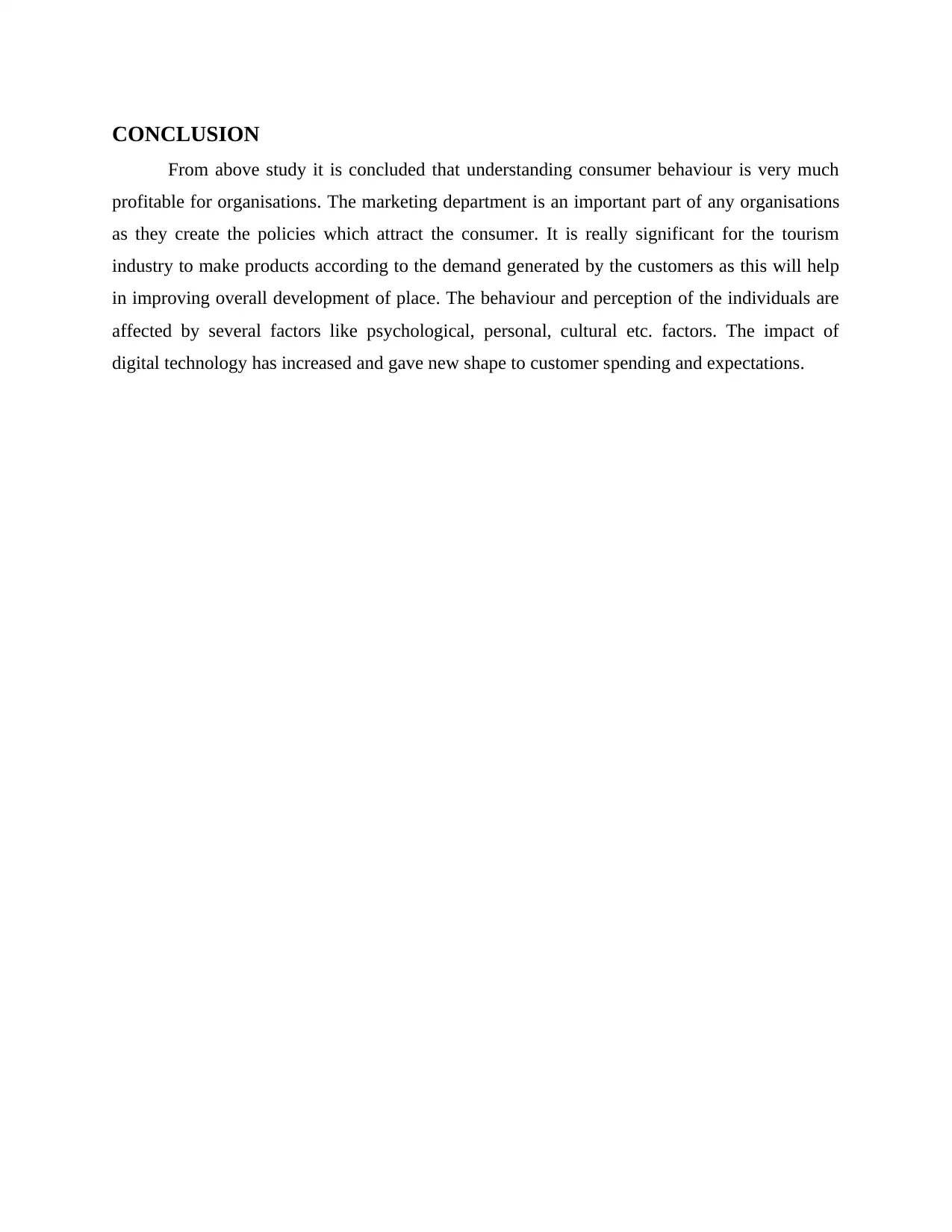
CONCLUSION
From above study it is concluded that understanding consumer behaviour is very much
profitable for organisations. The marketing department is an important part of any organisations
as they create the policies which attract the consumer. It is really significant for the tourism
industry to make products according to the demand generated by the customers as this will help
in improving overall development of place. The behaviour and perception of the individuals are
affected by several factors like psychological, personal, cultural etc. factors. The impact of
digital technology has increased and gave new shape to customer spending and expectations.
From above study it is concluded that understanding consumer behaviour is very much
profitable for organisations. The marketing department is an important part of any organisations
as they create the policies which attract the consumer. It is really significant for the tourism
industry to make products according to the demand generated by the customers as this will help
in improving overall development of place. The behaviour and perception of the individuals are
affected by several factors like psychological, personal, cultural etc. factors. The impact of
digital technology has increased and gave new shape to customer spending and expectations.
⊘ This is a preview!⊘
Do you want full access?
Subscribe today to unlock all pages.

Trusted by 1+ million students worldwide
1 out of 13
Related Documents
Your All-in-One AI-Powered Toolkit for Academic Success.
+13062052269
info@desklib.com
Available 24*7 on WhatsApp / Email
![[object Object]](/_next/static/media/star-bottom.7253800d.svg)
Unlock your academic potential
Copyright © 2020–2025 A2Z Services. All Rights Reserved. Developed and managed by ZUCOL.




